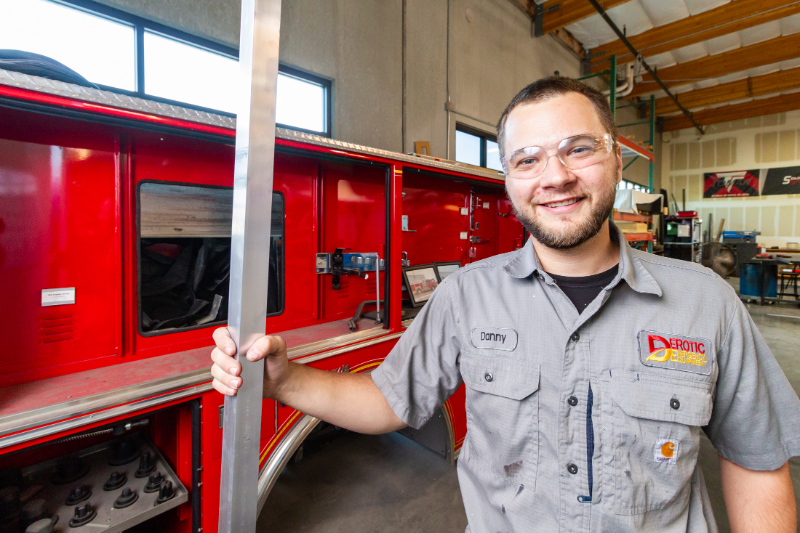The Importance of Emergency Vehicle Maintenance for First Responders

Emergency vehicles are the backbone of first responders' operations, providing crucial support in times of crisis. Whether it's an ambulance rushing to save a life, a fire truck battling a blaze, or a police car responding to an emergency call, these vehicles are relied upon to perform under pressure. However, ensuring the reliability, safety, and performance of emergency vehicles goes beyond just having them available—it requires meticulous maintenance and care. In this article, we'll delve into the critical importance of emergency vehicle maintenance for first responders.
Reliability and Performance
Reliability: When lives are on the line, there is no room for error. Well-maintained vehicles are essential for ensuring that first responders can rely on their fleet to function seamlessly during emergencies. From routine oil changes to tire inspections, every aspect of maintenance contributes to the overall reliability of the vehicle. A breakdown during transit can lead to catastrophic consequences, underscoring the importance of proactive maintenance practices. By prioritizing reliability, you can instill confidence in your teams and ensure they are prepared to tackle any situation.
Performance: Optimal performance is equally crucial for emergency vehicles. Well-maintained vehicles not only need to be reliable but also capable of performing at their best when called upon. Routine maintenance tasks such as engine tune-ups and fluid checks help ensure that vehicles operate efficiently and effectively. Whether it's accelerating to reach the scene of an emergency or maneuvering through traffic with precision, performance-oriented maintenance practices are essential.
Safety
Safety is paramount in the world of emergency response. Well-maintained vehicles not only protect the lives of responders but also safeguard the public they serve. Regular maintenance checks help identify potential issues before they escalate into safety hazards. Here are some specific safety measures that should be included in regular maintenance routines:
- Brake System Inspections: Regular checks of the brake system, including brake pads, rotors, and hydraulic components, ensure optimal performance when stopping in emergency situations.
- Emergency Lighting and Sirens: Ensuring that emergency lighting and sirens are in proper working order is essential for alerting other motorists and pedestrians to the presence of an emergency vehicle.
- Tire Inspections: Monitoring tire tread depth and pressure helps prevent blowouts and ensures traction, especially during adverse weather conditions.
- Fluid Levels and Leaks: Regularly checking fluid levels, including oil, coolant, and hydraulic fluids, helps prevent engine damage and overheating.
- Electrical System Checks: Inspecting the electrical system, including batteries and wiring, helps prevent electrical failures that could compromise vehicle safety.
By adhering to strict maintenance schedules and protocols, you can minimize the risk of accidents and uphold their duty to protect both responders and the community. These safety measures not only enhance the reliability and performance of emergency vehicles but also contribute to the overall effectiveness of emergency response operations.
To learn more about our preventive maintenance services for emergency vehicles, click here!
Response Time
In emergencies, every second counts. Vehicle maintenance directly impacts response time, with well-maintained vehicles capable of reaching the scene faster and more efficiently. From engine tune-ups to fuel system checks, proactive maintenance measures can significantly reduce the risk of unexpected breakdowns that could delay response times. Swift arrival at the scene can make all the difference in saving lives and mitigating damage. By investing in regular maintenance, you can optimize response times and enhance your organization's effectiveness in emergency situations.
Cost Savings
Maintaining emergency vehicles involves expenses, but the investment is far outweighed by the savings and benefits it brings. Here's how:
- Preventive Maintenance: Addressing minor issues before they become major problems is key to cost savings. Regular inspections and servicing can prevent breakdowns and costly repairs down the line.
- Extended Vehicle Lifespan: Proper maintenance extends the lifespan of vehicles, reducing the need for premature replacements. This not only saves on vehicle acquisition costs but also ensures continuity of service.
- Fuel Efficiency: Well-maintained vehicles operate more efficiently, resulting in lower fuel consumption. According to a study by the U.S. Department of Energy, proper maintenance can improve fuel efficiency by up to 4%.
- Reduced Operational Costs: By minimizing downtime and maximizing efficiency, maintenance helps reduce operational costs associated with vehicle downtime, repairs, and replacements.
While the upfront costs of maintenance may seem daunting, they pale in comparison to the potential expenses incurred from neglect. Preventive maintenance is a cost-effective approach that can save organizations significant sums in the long run. By addressing minor issues before they escalate into major problems, you can avoid costly repairs and extend the lifespan of your vehicles.
Legal Compliance
In addition to the moral imperative of maintaining emergency vehicles, there are also legal obligations and regulatory requirements to consider. Compliance with industry standards and government regulations is non-negotiable when it comes to emergency vehicle maintenance. From adhering to maintenance schedules outlined by manufacturers to conducting regular inspections mandated by regulatory agencies, organizations must ensure that their vehicles meet all safety standards and specifications. Failure to comply with these regulations can result in legal repercussions, fines, and even jeopardize the organization's ability to operate.
Final Thoughts
In conclusion, emergency vehicle maintenance is a critical aspect of first responders' operations, with far-reaching implications for reliability, safety, response time, cost savings, and legal compliance. By prioritizing proactive maintenance practices, organizations can ensure that their fleet is always ready to respond to emergencies effectively. From routine inspections to comprehensive maintenance schedules, every effort contributes to the overall effectiveness and efficiency of emergency response operations. By investing in maintenance today, organizations can safeguard their future and fulfill their duty to serve and protect their communities.
Contact Us
We're your one-stop shop for emergency and commercial vehicle repair and maintenance services in Rancho Cordova, Sacramento & San Bernardino, California. Get in touch with us today to schedule repairs or inquire about sales.

